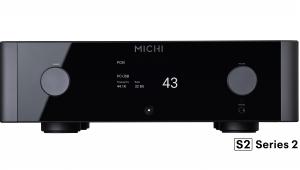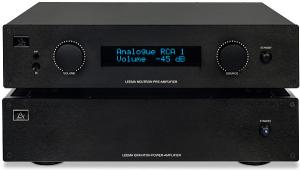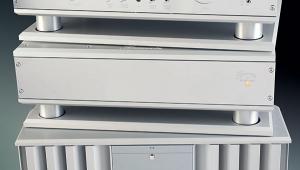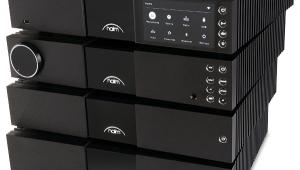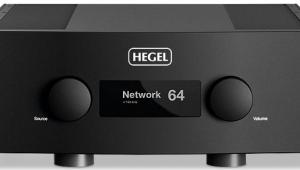Leema Acoustics Pyxis/altair Iv (£3925 /£8325 Each)
You might be surprised to see Leema launching a massive £20,000-plus amplifier combination now, hard on the heels of its lower-cost Pulse and Stream models. But as with everything this company does, there’s a logical progression. The Pyxis/Altair IV combination forms the heart of Leema’s long-considered reference series.
‘We needed to produce our reference system,’ says Mallory, ‘and from the outset it was always going to be monoblocks. It’s a reasonable compromise between power and load on the mains. As with all our designs, it’s about current and control, so the power supply is the most important thing, to start with. There is a massive 2600VA transformer that is specially wound for low noise.
‘After that, everything that follows is equally massive, with nearly an eighth of a Farad reservoir capacitance per module – and of course there are four modules altogether, in bridged mode. It’s really like having a hyper-Tucana on each heatsink.’
Speakers came first, but electronics were always on the agenda. Starting in 1998, founders Lee Taylor and Mallory Nicholls built Leema’s reputation with the little Xen mini-monitor, and successfully followed up with larger boxes. Then came the Cygnus phono stage, a £5000 attention-grabber that paved the way for the Tucana integrated amplifier and other components. Lee and Mallory were determined to offer products, and indeed systems, which would do everything, but do it easily and simply, even in the most complex multichannel installation. To achieve this they came up with LIPS (Leema Intelligent Protocol System). Even the most complicated array of Leema electronics, when connected by the LIPS communication bus, could be controlled from the Tucana integrated amp, or simply activated by the source component. In essence, all the user has to do is select a source, two-channel or multichannel, and the system will configure itself appropriately.
So, as the control centre for Leema’s Reference system, the Pyxis preamplifier has every feature and facility you could want. But the complexity is all on the inside. There is no quirky user interface, no cumbersome menu, no flight-deck-style remote.
Apart from the Standby button, which brings the preamp – and the connected Altair IV power amplifiers – to life, there are just two main controls. The volume control, actually a rotary encoder, is surrounded by blue LEDs which indicate the volume setting. Turning the smaller source selector knob cycles through the inputs, and pressing it switches between the Listen input and Record output modes, indicated by blue and red LEDs respectively for each source.
HIDDEN CONTROLS
Five of the six small buttons, five (AV Direct, Eq on/off, Invert phase, Mono and Mute) are self explanatory, while the sixth one, Setup, is simple and intuitive in use. Pressing Setup, either on the fascia or on the remote, will access in turn the hidden Bass, Treble, Balance and Gain controls, as indicated by LEDs below the volume control. Each can be adjusted using the volume knob or the remote’s arrow keys. Settings are remembered individually for each input, including the front-panel MP3 input which replaces Aux when in use. Along with the usual array of line-level RCA inputs, there is a coaxial digital input and output, and a USB port.
On the back are XLR inputs for a balanced-output CD player like Leema’s Antila, and another pair to connect an external, balanced-output phono stage like the Agena. Unbalanced inputs cater for other external phono amps, and for the Pyxis’ optional MM/MC phono stage, if fitted. For the LIPS control system, there are the 3.5mm LIPS 1 jacks and the LIPS 2 balanced outputs for connection to the Altair amps. Finally, there are balanced and unbalanced preamp outputs.
QUITE A START
Once you’ve heaved each 45kg Altair IV out of its box, you realise that it is a compact amp, considering its weight. It isn’t quite a cube, although it might have been aesthetically nicer if it was, but it conforms to rack-mounting standards with an imposing height of 9U (390mm).
Each front panel carries a suitably mega version of Leema’s usual level display, in this case, of course, with no volume control in the middle of it. During start-up, all 32 blue LEDs flash simultaneously for a few seconds, which is quite spectacular. Neatly completing the circle below are two status LEDs which you hope never to see come on, for Start Error and Overheat, and one for Protection – which does flash briefly when powering down to Standby.
On the back panel are more connections and controls than on your average power amp. For control signals from the Pyxis, there is a 5-pin locking XLR LIPS 2 connector. As well as a LIPS 1 mini-jack output there are LIPS 2 pass-through outputs allowing a second Altair pair to be connected and controlled automatically for bi-wiring. Next to these sockets is the crucial Gain Mode switch, which must be set to LIPS mode for use with the Pyxis or other LIPS-equipped Leema preamps, or to Fixed gain for use with conventional preamps.
Balanced (XLR) and unbalanced (phono) signal inputs and corresponding pass-through signal outputs provide for multi-amp installations. Four massive WBT speaker binding posts allow for bi-wiring.
Each Altair IV is ‘handed’ left or right, since the software is set to give correct operation of the balance control, and of the soft-start sequence, which staggers the turn-on of the two amps to avoid undue mains draw.
WALK TO FREEDOM
For this review I was able to complete the electronics line-up with Leema’s Antila II CD player, also with balanced outputs. Ladysmith Black Mambazo’s 2006 album Long Walk To Freedom highlighted some of the best qualities of the combination. I think the exceptional control in the bass was the foundation for a kind of solid, tangible sound picture of those amazing African voices in which tiny details could be heard effortlessly, presented naturally, never just popping up like some sort of conjuring trick.
Because of this, the system revealed the intriguing contrasts created by the guest stars on this album and it was fascinating to hear Natalie Marchant’s engagingly sour intonation on ‘Beautiful Rain’, or the immediacy and impact of the only instrumental sound, Taj Mahal’s electric guitar in ‘Mbube’.
A couple more discs both illustrated the Leema amp’s fine control of the lower reaches. In the superbly glossed-up remake of the ‘The Pink Panther Theme’ on Ultimate Mancini [Concord SACD-1034-6], the big-sounding electric bass had power, but never overpowered, and this luxuriously recorded disc simply glowed. Coming from a different musical world, but still revealing the Leema’s virtues of control in the bass and unforced detail in the mid and treble, was Marta Gomez and Entre Cada Palabra [Chesky JD301]. You couldn’t fail to be captivated as the Leema amps hung the singer’s unaccompanied voice right in front of you on ‘Está Linda la Mar’, and the way Anat Cohen stole up behind to complement her lovely vocal timbres with a low-register clarinet part.
Turning to another clarinetist, the late Arne Domnerus (who passed away in September 2008), I was struck by the sheer fluidity and rhythmic rightness of Jazz At The Pawnshop [Proprius PRSACD 7879], and even more than usual, by a great transparency in the recorded texture. By which I mean that, as in a live performance, you could just focus on any instrument at any moment, and hear exactly what it was doing without effort. Percussion sounds were very real, and you could finally appreciate that Egil ‘Bop’ Johansen was, actually, a great drummer. On the relatively quiet ‘I’m Confessing’, you could almost see the audience sitting in a respectful hush, but here, as with this album’s magical opening, the ambient picture became positively
three-dimensional with footsteps and clinking glasses.
TRUE PICTURE
And so to a favourite test of dynamic range, the LSO’s 2006 recording on its own label of Beethoven’s Fifth under Haitink [LSO Live LSO 0590]. The big Leema amplifiers handled this with aplomb, and for once it was easy to find a volume setting which worked in the room. Climaxes were rendered very successfully, with the various sections of the orchestra holding their own and retaining some spatial tangibility even in the potentially overwhelming presence of the tympani, for example.
Presumably thanks to the amp’s generous headroom, you never had the impression that the recorded dynamics were being crushed, or that the system was being driven into distortion. Instead, the Leema revealed what I think is a truer picture of what is on the disc, the sound of a magnificent orchestra which inevitably sometimes just hits the stops of the Barbican acoustic.
Encouraged by this, I got out a ‘difficult’ CD that had been gathering dust for a while, Mitsuko Uchida’s Debussy Etudes [reissued as Philips 464 698-2]. Here the piano is in some danger of being swamped in the almost ridiculously reverberant Snape acoustic, and in loud, fast passages the effect can be simply unpleasant on many systems. But the Leema sailed through these testing sections and, while still sounding bright and even rather harsh, the ear could still decode a piano plus reflections, rather than just a mess. And I felt that the character of Uchida’s playing came through quite vividly.
And so, these products do deliver the stellar performance that their names might lead you to hope for. When it came to the Altair, though, Lee and Mallory couldn’t resist an amplifier maker’s in-joke, adding the ‘IV’ so that the amplifier was named not after the star itself, but after its famous fictional planet. (Hint: look at both the poster and power amplifier in this month’s ‘Hi-Fi@Home’, p80.)
GIMME SOME LIP
Thanks to LIPS, Leema’s electronics not only sound great, but are easy to use. In fact, it’s a lot easier to use them than to explain how it’s done. Mallory’s long experience in designing monitoring control systems for studios, where it’s imperative to have foolproof, intuitive operation of a multitude of units, may have quite a lot to do with this.
That studio background must also have something to do with the way Leema products are built, and built to last. Above all, and unlike so many high-end hopefuls, these seemingly bomb-proof Leema electronics just inspire confidence. One thing’s for sure, they can be warmly recommended.
VERDICT
Even if the Pyxis and Altair IV don’t lead their rivals to self-destruct, they do prove that complex high-end products really can be easy use. If you’re contemplating a big system, especially one that will go beyond two channels or further than a single room, these innovative, well- thought-out and superbly- built British-made components must surely be front-runners.
Originally published in the April 2009 issue





